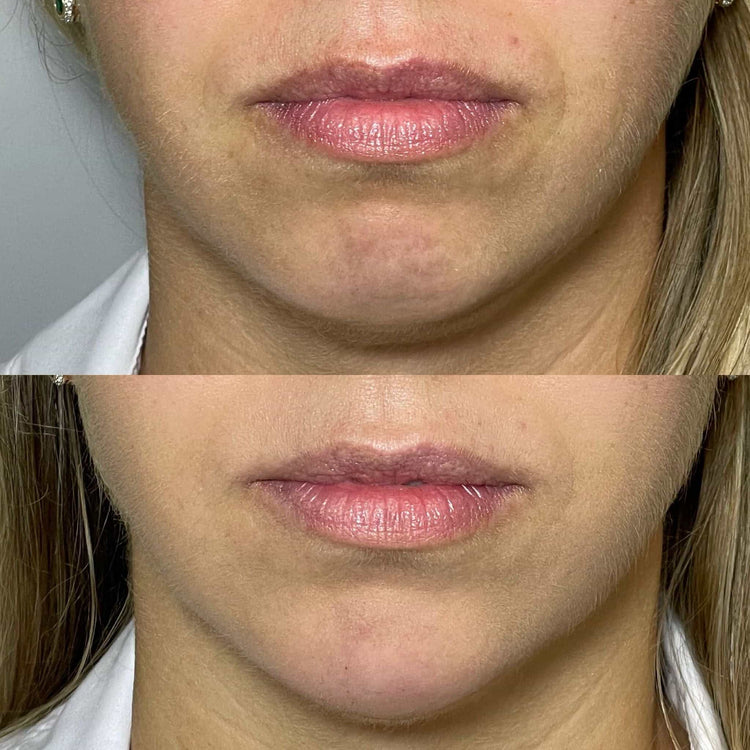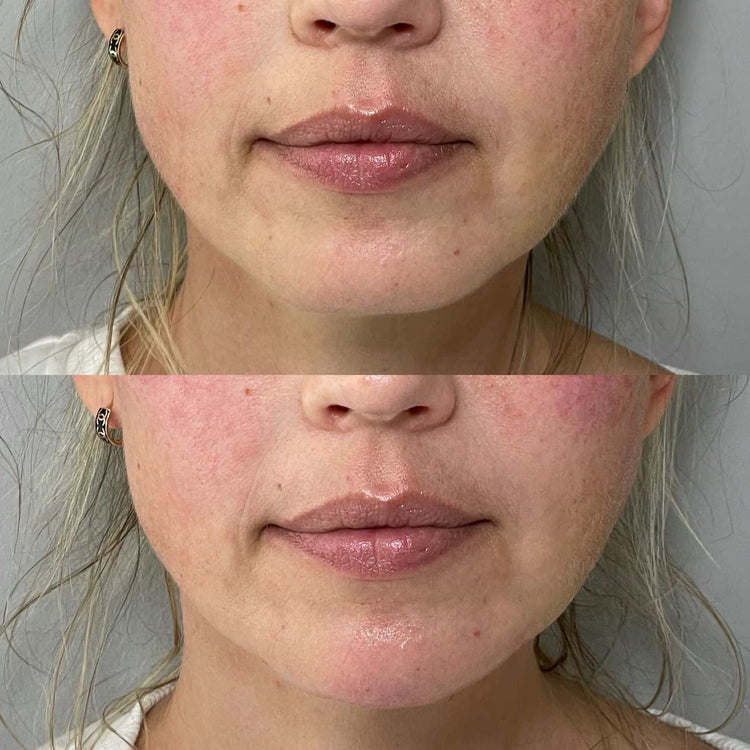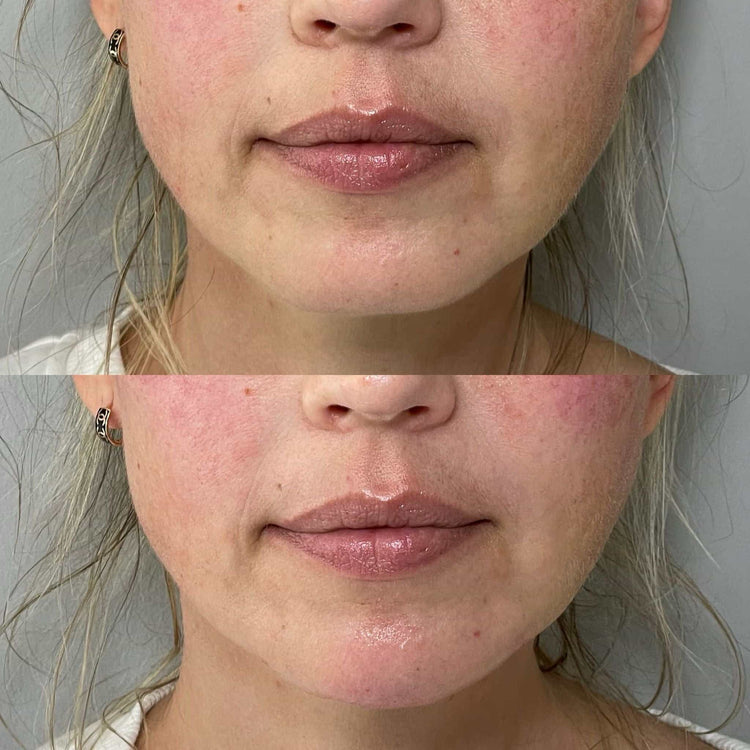Understanding Labiomental Creases
Labiomental creases, also known as nasolabial folds or smile lines, are prominent lines that extend from the nose to the corners of the mouth. These creases can develop naturally with age due to facial movements and gravity, but they can also be influenced by genetics and sun exposure. While many view these creases as a natural part of aging, some individuals may desire smoother skin and a more youthful appearance.
Anatomy and Formation
Labiomental creases are formed by the intersection of muscle action and the downward pull of gravity. The muscles responsible for smiling and speaking, like the orbicularis oris and levator labii superioris, create dynamic lines as they contract and relax. Over time, repeated contractions can etch these lines deeper into the skin, especially in areas where fat pads have decreased due to aging.
The formation of labiomental creases is also influenced by facial structure. Individuals with prominent nasolabial folds may have a flatter midface, which accentuates the crease’s appearance. Additionally, sun exposure can contribute to collagen and elastin breakdown, further deepening the creases over time.
Contributing Factors
Preventing the deepening of labiomental creases often involves a multi-faceted approach that addresses both muscle activity and structural factors. Reducing facial expressions that exacerbate the creases through conscious relaxation techniques and mindful movement can help minimize their prominence. Protecting the skin from sun damage with sunscreen and wearing protective clothing is crucial for preserving collagen and elastin, which are essential for maintaining skin elasticity and reducing the appearance of wrinkles.
In addition to lifestyle modifications, dermal fillers can be an effective solution for smoothing labiomental creases. These injectable substances, often hyaluronic acid-based, add volume to the areas surrounding the crease, effectively plumping up the skin and minimizing the appearance of lines. The results are typically long-lasting, although touch-up treatments may be needed over time.
Choosing a qualified and experienced injector is essential when considering fillers for labiomental creases. They will assess your individual anatomy, skin type, and desired outcome to determine the most suitable filler type and injection technique.
Filler Selection for Treatment
Labiomental creases, also known as nasolabial folds or smile lines, can significantly impact a person’s appearance as they become more prominent with age. These deep lines extending from the nose to the corners of the mouth are formed by a complex interplay of muscle action and gravity. While some consider them a natural part of aging, many individuals seek methods to minimize their appearance and maintain a youthful look.
Types of Fillers Suitable for this Area
Choosing the right dermal filler for labiomental creases is crucial for achieving natural-looking results and minimizing the risk of complications.
- Hyaluronic acid (HA) fillers are the most commonly used type for addressing nasolabial folds. HA attracts and retains moisture, plumping the skin and smoothing out wrinkles. Various HA fillers are available, each with different viscosities and longevity.
- Calcium hydroxylapatite (CaHA) is another option that stimulates collagen production, providing long-lasting volumization and skin rejuvenation.
- Poly-L-lactic acid (PLLA) fillers work by gradually stimulating collagen synthesis over time, leading to a gradual reduction in wrinkle depth and improved facial contours.
Filler Concentration Considerations
When choosing a hyaluronic acid filler for labiomental creases, the concentration plays a vital role in achieving natural-looking results. Lower concentrations are typically used for superficial wrinkles and fine lines, while higher concentrations provide more volume for deeper folds. An experienced injector will assess the individual’s needs and determine the optimal concentration based on factors like skin thickness, desired outcome, and potential bruising or swelling risks.
A higher concentration of filler may lead to a more dramatic correction, but it can also increase the risk of visible lumps or bumps if not injected properly. Conversely, a lower concentration may provide subtle improvements but might not be sufficient for deeply etched creases. Striking the right balance between volume and natural-looking results is key.
Injection Technique
Injection techniques play a crucial role in achieving successful and aesthetically pleasing outcomes when treating labiomental creases with dermal fillers. The injector’s skill and expertise determine the placement, depth, and angle of injections, influencing the final appearance and longevity of the results.
Strategic Placement Points
Strategic placement points for injecting dermal fillers into labiomental creases aim to restore volume and smooth out the lines while maintaining a natural look. Injectors typically target three key areas: the nasolabial fold itself, the upper lip border, and the transition zone between the nose and the cheek.
Within the nasolabial fold, injections are placed in a fanning pattern, gradually increasing depth as they approach the corners of the mouth. This technique helps to lift and volumize the skin along the crease, minimizing its appearance without creating an overly inflated effect.
Injections along the upper lip border add fullness and support to the area, softening the transition between the lip and the fold. This can help create a more youthful, sculpted appearance.
The transition zone, located just below the nose, is another strategic injection point. Injecting filler into this area can help lift the corners of the mouth, creating a subtle lift and reducing the prominence of the nasolabial fold.
Volume Distribution
Injection technique plays a crucial role in achieving successful and aesthetically pleasing outcomes when treating labiomental creases with dermal fillers. The injector’s skill and expertise determine the placement, depth, and angle of injections, influencing the final appearance and longevity of the results.
Strategic placement points for injecting dermal fillers into labiomental creases aim to restore volume and smooth out the lines while maintaining a natural look. Injectors typically target three key areas: the nasolabial fold itself, the upper lip border, and the transition zone between the nose and the cheek.
Within the nasolabial fold, injections are placed in a fanning pattern, gradually increasing depth as they approach the corners of the mouth. This technique helps to lift and volumize the skin along the crease, minimizing its appearance without creating an overly inflated effect.

Injections along the upper lip border add fullness and support to the area, softening the transition between the lip and the fold. This can help create a more youthful, sculpted appearance.
The transition zone, located just below the nose, is another strategic injection point. Injecting filler into this area can help lift the corners of the mouth, creating a subtle lift and reducing the prominence of the nasolabial fold.
Volume distribution is essential for achieving natural-looking results with dermal fillers for labiomental creases. An experienced injector will carefully assess the individual’s facial anatomy and desired outcome to determine the optimal amount of filler to be placed in each targeted area.

Overfilling a single area can lead to an unnatural appearance, such as a “chipmunk cheek” effect or overly prominent upper lip. Conversely, using too little filler may not address the creases sufficiently, resulting in underwhelming results.
Achieving a balanced and harmonious distribution of volume is crucial for creating natural-looking results that enhance facial contours without appearing artificial.
Correcting Asymmetry
When considering dermal fillers to address labiomental creases, it’s important to understand the role of injection technique in achieving desired outcomes.
A skilled injector will utilize precise placement and depth to ensure a natural-looking result. Injectors often employ a “fanning” technique within the nasolabial fold, gradually increasing depth as they approach the corners of the mouth. This helps lift and volumize the skin along the crease while avoiding an overly inflated appearance.
Strategic injection points are selected based on individual anatomy and desired outcomes. Areas often targeted include the nasolabial fold itself, the upper lip border, and the transition zone between the nose and cheek. Injecting filler into these zones can create a subtle lift, smooth out lines, and enhance facial contours.
Careful attention to volume distribution is equally crucial. Too much filler in one area can lead to an unnatural appearance, while too little may not adequately address the creases. Experienced injectors assess facial anatomy and desired outcomes to determine the optimal amount of filler for each targeted zone, ensuring a balanced and harmonious result.
Post-Treatment Care
Preventing the deepening of labiomental creases is a multifaceted process that often involves a combination of lifestyle modifications and medical treatments.
Swelling Management

Swelling management after treatment is crucial for achieving optimal results and minimizing discomfort. It’s normal to experience some swelling, redness, or bruising following dermal filler injections. However, these side effects are typically temporary and subside within a few days to a week.
To manage swelling, it’s essential to follow your injector’s instructions carefully. This may include applying cold compresses to the treated area for 15-20 minutes at a time, several times a day. Avoid touching or rubbing the injection sites as this can irritate the skin and worsen swelling.
Elevating your head while sleeping can also help reduce swelling. Additionally, avoid strenuous activities, excessive sun exposure, or alcohol consumption for a few days after treatment, as these can exacerbate inflammation.
Protecting the Treated Area
Protecting the treated area is vital after dermal filler injections to ensure optimal results and minimize the risk of complications.
- Avoid touching or rubbing the injection sites for at least a few days following treatment. This can irritate the skin, cause bruising or swelling, and potentially displace the filler.
- Apply cold compresses to reduce swelling and discomfort. Wrap ice cubes in a towel and apply them to the treated area for 15-20 minutes at a time, several times a day.
- Avoid strenuous activities and excessive sun exposure for a few days after treatment, as these can increase blood flow and potentially worsen swelling or bruising.
- Don’t massage or manipulate the treated area. This can disrupt the filler placement and lead to uneven results.
- Wear loose-fitting clothing to avoid friction against the injection sites and minimize irritation.
It is essential to follow your injector’s post-treatment instructions carefully for optimal healing and long-lasting results. They will provide specific advice regarding activities to avoid, skincare routines, and potential side effects. If you experience any concerning symptoms or have questions about the recovery process, don’t hesitate to contact your injector.
Avoiding Certain Activities
After treatment with dermal fillers for labiomental creases, there are certain activities you should avoid to ensure proper healing and prevent complications.
These include:
- Strenuous exercise: Avoid intense workouts or activities that elevate your heart rate for several days following treatment. This can increase blood flow and potentially displace the filler.
- Sauna or steam room: Avoid excessive heat exposure as it can lead to swelling and irritation.
- Massage or facial manipulation: Do not massage the treated area, as this can disrupt the filler placement and affect results.
- Touching or rubbing the injection sites: Avoid touching or rubbing the treated areas excessively to prevent irritation and bruising.
- Alcohol consumption: Limit alcohol intake for a few days after treatment, as it can interfere with healing and increase swelling.
It’s important to follow your injector’s post-treatment instructions carefully and reach out if you have any concerns.
Long-Term Maintenance
Preventing the deepening of labiomental creases often involves a multi-faceted approach that addresses both muscle activity and structural factors. Reducing facial expressions that exacerbate the creases through conscious relaxation techniques and mindful movement can help minimize their prominence. Protecting the skin from sun damage with sunscreen and wearing protective clothing is crucial for preserving collagen and elastin, which are essential for maintaining skin elasticity and reducing the appearance of wrinkles.
Dermal fillers can be an effective solution for smoothing labiomental creases. These injectable substances, often hyaluronic acid-based, add volume to the areas surrounding the crease, effectively plumping up the skin and minimizing the appearance of lines. The results are typically long-lasting, although touch-up treatments may be needed over time.
Choosing a qualified and experienced injector is essential when considering fillers for labiomental creases. They will assess your individual anatomy, skin type, and desired outcome to determine the most suitable filler type and injection technique.
A skilled injector will utilize precise placement and depth to ensure a natural-looking result. Injectors often employ a “fanning” technique within the nasolabial fold, gradually increasing depth as they approach the corners of the mouth. This helps lift and volumize the skin along the crease while avoiding an overly inflated appearance.
Strategic injection points are selected based on individual anatomy and desired outcomes. Areas often targeted include the nasolabial fold itself, the upper lip border, and the transition zone between the nose and cheek. Injecting filler into these zones can create a subtle lift, smooth out lines, and enhance facial contours.
Careful attention to volume distribution is equally crucial. Too much filler in one area can lead to an unnatural appearance, while too little may not adequately address the creases. Experienced injectors assess facial anatomy and desired outcomes to determine the optimal amount of filler for each targeted zone, ensuring a balanced and harmonious result.
It’s essential to follow your injector’s post-treatment instructions carefully for optimal healing and long-lasting results. They will provide specific advice regarding activities to avoid, skincare routines, and potential side effects. If you experience any concerning symptoms or have questions about the recovery process, don’t hesitate to contact your injector.
- Navigating Power Dynamics In Dominant-Submissive Relationships - June 3, 2025
- What Is The Relationship Escalator And Should You Follow It? - June 2, 2025
- What Helps Lip Filler Swelling - June 1, 2025
